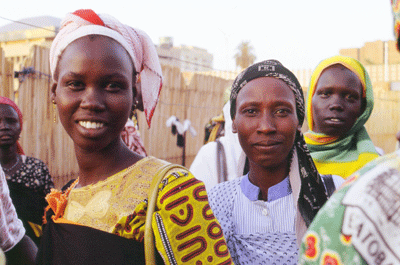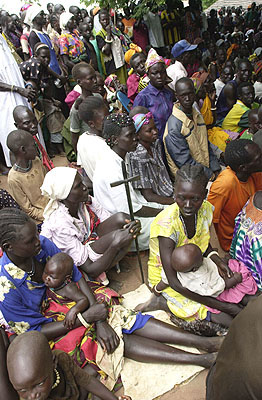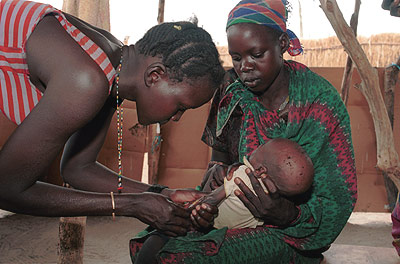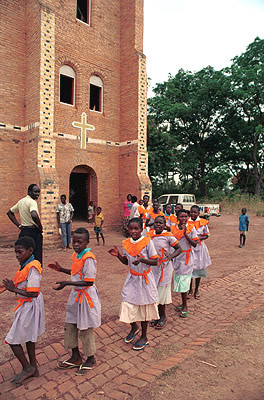
and human security

|
|

|
|

|
|

|
|

|
|

|
|

|
|
 |
|
 |
SUDAN - HISTORY Sudan, located in northeast Africa on the Red Sea, is the largest country in Africa. It is also one of the most violent and poverty-stricken. It has known only 10 years (1972-82) without civil war and massive population displacement since it was granted independence from Britain in 1956. The wars are rooted in northern economic, political, social, and religious domination of the non-Muslim, non-Arab southern Sudanese people. It is estimated by the UN and churches that since the war resumed in 1983, more than 2 million people have died and four to five million displaced due to war- and famine-related causes. In 2003 Islamic extremists attacked black Sudanese in the western Darfur region where thousands died and more than a million more displaced in a humanitarian disaster that continued through 2004. Bordered by Eritrea, Ethiopia, Kenya, Uganda, the Democratic Republic of the Congo, Central African Republic, Chad, Libya, and Egypt. Sudan has a long history that has been dominated in the north by Arab and Egyptian influence and is strongly oriented towards radical Islam in recent years. Approximately 40% of the country’s population are Arabs, who live mostly in the north. Various black African tribal and ethnic groups comprise the population of the south, which is largely Christian or animist. A major division has existed between the North and South since before independence and in 1955 as preparations to end British colonial rule were under way, southern provinces began to rebel against rule from the Muslim north. Successive governments, both civilian and military have been unable to deal with the tensions and civil wars raged for 17 years when negotiators from the All Africa Conference of Churches and the World Council of Churches and neighbouring countries were able to negotiate a peace agreement which lasted for a decade. During that time, attempts to grant the southern African region a form of autonomy or self-government were attempted but failed while inter-tribal struggles over land a cattle made the region a tinderbox. With the discovery of oil in the south and demands by the Khartoum government that the revenues go to the national government, war broke out again in 1983 and there has been no peace since. The divisions have existed for several centuries, when northern Sudan was part of a region called Nubia, governed by local kingdoms dominated by Egypt. Beginning in the 14th century, these northern regions became Islamic, and in 1820 the kingdom was invaded by Egypt, setting up an Islamic state that was later governed as a colony by the British. From the 1880s there was a series of wars between the Sudanese, British, and Egypt, which ended in 1956 with the establishment of the Republic of Sudan. Since 1983 the conflict has been more and more deadly and brutal with the Sudanese People’s Liberation Army (SPLA), which controls parts of the south, and the Muslim Arab government based in Khartoum. Since 1989 the ruling regime has been a mixture of military elites and a fundamentalist Islamist party which took power in a coup. In 1999 the army dissolved the National Assembly and suspended the Constitution. Peace initiative talks in 2002 hold some promise of a resolution of the conflict. Decades of war have led to a large refugee population, as well as millions of landmines around the country. Children have been kidnapped and forced to serve as soldiers. Slavery is another monstrous human rights violation, which has continued for more than 300 years. North African Arabs and Arab Moors buy, sell and breed black Africans for the slave trade. The country has been ravaged by drought, famine, desertification, soil erosion, poaching of endangered animal species and excessive hunting. The oil fields of southern Sudan have been developed by international corporations but are also the cause of brutal repression of southerners who are demanding a share of the lucrative royalties. Islam is the religion of the majority of the population, although Christianity has a long history in the Sudan, beginning with the arrival of Coptic Christians during the 4th century and Melkite missionaries in 543. Christianity flourished until the 14th century, when Islam dominated and extinguished all Christian presence. Roman Catholic missionaries arrived in 1861, although their mission was largely destroyed during an insurrection in 1881. The Roman Catholic Church was re-established in 1898, and the Anglicans followed soon after. Today, the Roman Catholic and Anglican churches are by far the largest denominations in the Sudan. There are also Coptic, Ethiopian, and Greek Orthodox churches. The Sudan Council of Churches was established, with headquarters in Khartoum, in 1965 and includes Roman Catholic, Orthodox, Protestant, and Anglican churches. It has an exiled wing, the New Sudan Council of Churches, based in Nairobi, Kenya. While the two councils see themselves as one, the many years of war and destruction war have made it impossible to serve as an ecumenical resource for the southern Christians. The NSCC maintains regular contacts with the churches of the south, both spiritually and materially, helping with education, humanitarian assistance, refugee support and spiritual solidarity between and among churches, all of whom, including the Roman Catholic, maintain close ecumenical ties in a fractured country. |
|
|||||||



